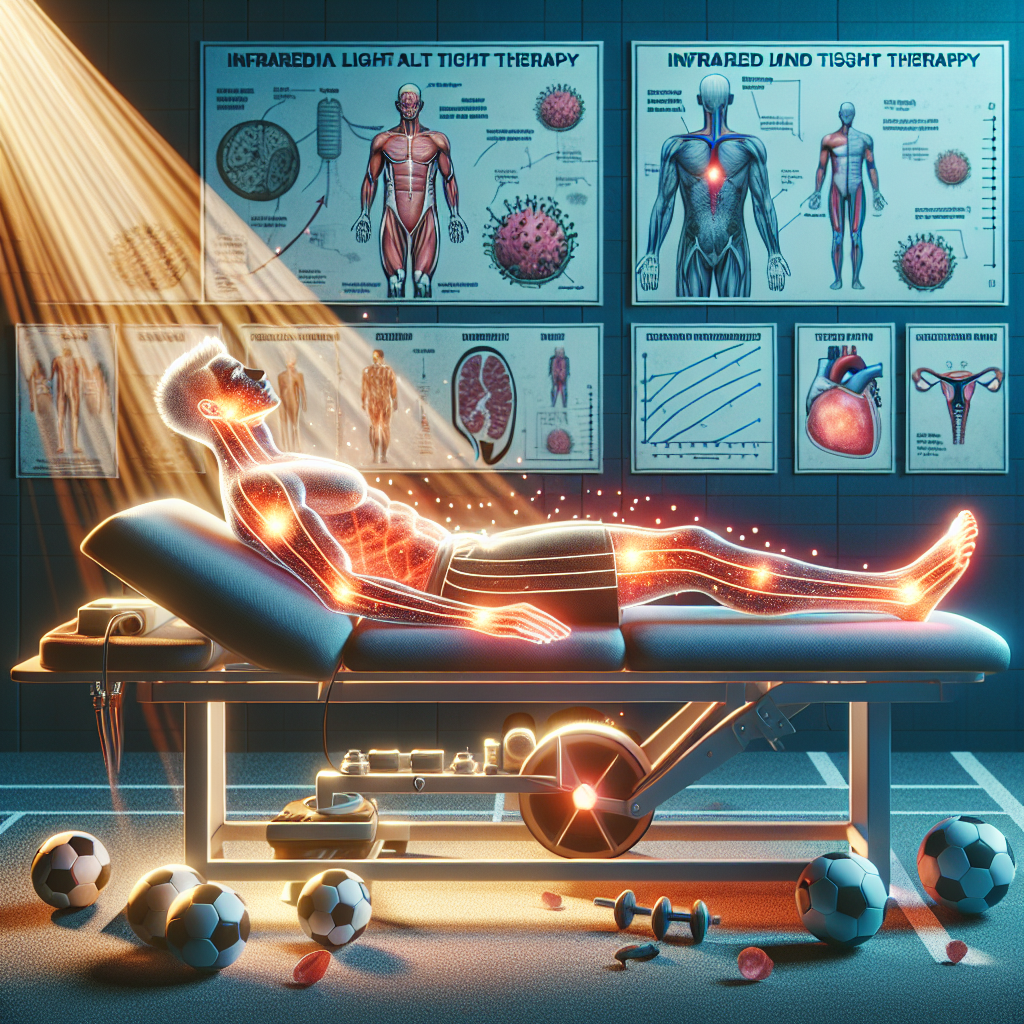
Can Infrared Light Therapy Aid In Sports Injury Recovery?
Imagine being able to speed up your sports injury recovery by simply exposing your body to a specific type of light. Well, that’s exactly what infrared light therapy aims to do. By utilizing infrared light waves, this non-invasive treatment method has gained popularity in the sports world for its potential to accelerate healing and alleviate pain. Whether you’re a professional athlete or a weekend warrior, the question remains: can infrared light therapy truly aid in sports injury recovery? In this article, we will explore the science behind infrared light therapy and its potential benefits for athletes. So, let’s shed some light on this intriguing topic and discover if it’s the missing piece to your road to recovery.

This image is property of images.pexels.com.
What is Infrared Light Therapy?
Infrared Light Therapy, also known as Low-Level Laser Therapy (LLLT) or photobiomodulation therapy, is a non-invasive treatment that uses low levels of infrared light to promote healing and pain relief in the body. It involves the application of specific wavelengths of light to targeted areas of the body, stimulating cellular activity and promoting tissue repair.
The Science behind Infrared Light Therapy
Physics of Infrared Light
Infrared light is a form of electromagnetic radiation with longer wavelengths than visible light. It falls within the spectrum between visible light and microwaves. When infrared light is absorbed by the body, it penetrates deep into the tissues, reaching muscles, tendons, and even bones. This deep penetration allows for significant therapeutic effects.
How Infrared Light Affects the Body
When infrared light is absorbed by the body, it triggers a series of biochemical reactions within the cells. It stimulates the mitochondria, which are the powerhouses of the cell, to produce more adenosine triphosphate (ATP). ATP is responsible for providing energy to the cells, and increased production can enhance cellular function and accelerate the healing process. Infrared light also increases blood circulation in the treated area, bringing oxygen and nutrients to the injured tissues, while removing waste products and reducing inflammation.
Benefits of Infrared Light Therapy
Infrared Light Therapy offers several benefits for sports injury recovery. It can reduce pain and inflammation, promote tissue repair and regeneration, improve muscle strength and flexibility, and accelerate overall healing. This therapy is non-invasive, drug-free, and has minimal side effects, making it a safe and effective treatment option for athletes and active individuals.
Sports Injuries and Their Impact
Common Sports Injuries
Sports injuries are common occurrences among athletes and individuals involved in physical activities. These injuries can range from minor sprains and strains to more severe joint dislocations, fractures, and tears. Some common sports injuries include ankle sprains, muscle strains, knee injuries, shoulder dislocations, and stress fractures. These injuries can significantly impact an athlete’s performance, leading to pain, limited mobility, and extended periods of recovery.
The Importance of Proper Recovery
Proper recovery plays a crucial role in the rehabilitation process of sports injuries. It involves rest, appropriate medical treatment, and rehabilitation exercises to promote healing, restore function, and prevent future injuries. Neglecting proper recovery can result in chronic pain, long-term disabilities, and a higher risk of re-injury.
Infrared Light Therapy for Sports Injury Recovery
How Infrared Light Therapy Works for Injuries
Infrared Light Therapy aids in sports injury recovery by targeting the underlying causes of pain and inflammation. The application of specific wavelengths of infrared light to the injured area stimulates cellular activity, leading to increased ATP production, enhanced tissue repair, and reduced inflammation. This therapy also promotes blood circulation, optimizing the delivery of oxygen and nutrients to the injured tissues, which further accelerates the healing process.
Effectiveness of Infrared Light in Sports Injury Recovery
Numerous studies have demonstrated the effectiveness of Infrared Light Therapy in sports injury recovery. Research has shown that the application of infrared light can reduce pain, accelerate wound healing, and improve functional outcomes in athletes with various types of injuries, including muscle strains, joint injuries, and bone fractures. The non-invasive nature and minimal side effects of this therapy make it a valuable treatment option for athletes looking to recover quickly and safely.
Types of Injuries that Can Benefit from Infrared Light Therapy
Infrared Light Therapy can benefit athletes recovering from a wide range of sports injuries. Muscle strains and tears, such as hamstring strains or calf muscle tears, can benefit from increased cellular activity and improved circulation. Joint injuries, such as sprained ankles or dislocated shoulders, can benefit from reduced inflammation and enhanced tissue repair. Even bone fractures, such as stress fractures, can benefit from accelerated healing and improved bone formation with the use of Infrared Light Therapy.

This image is property of images.pexels.com.
Specific Applications in Sports Injury Recovery
Infrared Light Therapy for Muscle Strains and Tears
Muscle strains and tears are common sports injuries that can result from overuse, sudden movements, or inadequate warm-up. Infrared Light Therapy can help in the recovery process by promoting cellular activity and circulation in the affected muscles. This therapy can reduce pain, decrease inflammation, and accelerate the healing of muscle fibers, allowing athletes to return to their activities more quickly.
Infrared Light Therapy for Joint Injuries
Joint injuries, such as sprains or dislocations, can cause pain, instability, and limited range of motion. Infrared Light Therapy can aid in the recovery of joint injuries by reducing inflammation, stimulating tissue repair, and improving joint function. This therapy can alleviate pain, decrease swelling, and enhance the rehabilitation process, helping athletes regain strength and mobility in the injured joint.
Infrared Light Therapy for Bone Fractures
Bone fractures, especially stress fractures, can be challenging to heal and often require extended periods of rest. Infrared Light Therapy can assist in the recovery of bone fractures by promoting bone formation and mineralization. This therapy can accelerate the healing process, reduce pain, and improve the overall strength and density of the healed bone.
Using Infrared Light Therapy Alongside Other Treatments
Complementary Treatments for Enhanced Recovery
Infrared Light Therapy can be used alongside other conventional treatments and rehabilitation methods to enhance recovery. Physical therapy exercises, stretching, and strengthening programs can complement the effects of infrared light by promoting mobility, flexibility, and muscle balance. Additionally, ice or heat therapy, compression, and elevation can be used in combination with Infrared Light Therapy to manage pain, reduce swelling, and provide localized relief.
Possible Risks and Side Effects of Infrared Light Therapy
Infrared Light Therapy is generally safe when administered correctly. However, there are some potential risks and side effects associated with this treatment. Excessive exposure to infrared light can cause burns or skin damage, so it is essential to follow the recommended treatment protocols and duration. Additionally, individuals with certain medical conditions, such as sensitivity to light or skin disorders, should consult with a healthcare professional before undergoing Infrared Light Therapy.

This image is property of images.pexels.com.
Infrared Light Therapy Devices for Home Use
Types of Infrared Light Therapy Devices
There are various types of Infrared Light Therapy devices available for home use. Light therapy panels or pads, handheld devices, and wearable devices are some common options. Light therapy panels or pads can be placed on the affected area, providing a larger coverage area for treatment. Handheld devices offer more flexibility and precision, allowing users to target specific areas of the body. Wearable devices, such as infrared wraps or belts, provide convenience and mobility, enabling users to receive therapy while engaging in daily activities.
Considerations for Choosing an Infrared Light Therapy Device
When choosing an Infrared Light Therapy device for home use, several factors should be considered. Firstly, it is important to ensure that the device emits the appropriate wavelength of infrared light for the desired therapeutic effects. The device’s power output, treatment area coverage, and treatment duration should also be taken into account. Additionally, user-friendly features, such as adjustable intensity settings, timers, and portability, can enhance the overall experience and effectiveness of the therapy.
Case Studies and Success Stories
Real-life Examples of Athletes Using Infrared Light Therapy for Injury Recovery
Several athletes have reported positive results and improved recovery outcomes with the use of Infrared Light Therapy. Professional football players, tennis players, and even Olympic athletes have incorporated this therapy into their injury rehabilitation programs. Athletes have reported reduced pain, accelerated healing, and improved performance after undergoing Infrared Light Therapy.
Notable Sports Professionals Advocating Infrared Light Therapy
Prominent sports professionals, including trainers, coaches, and doctors, have come forward to advocate for the use of Infrared Light Therapy in sports injury recovery. These professionals recognize the benefits of this therapy in reducing pain, promoting tissue repair, and enhancing overall healing. The endorsement of these experts adds credibility to the efficacy of Infrared Light Therapy as a valuable treatment option for athletes.

Challenges and Limitations of Infrared Light Therapy
Availability and Accessibility of Infrared Light Therapy
Despite its growing popularity, access to Infrared Light Therapy may still be limited in some areas. Specialized clinics or healthcare facilities, equipped with the necessary devices and trained professionals, may not be readily available in all regions. Additionally, the cost of Infrared Light Therapy sessions may vary, and insurance coverage for this treatment option may be limited. These factors can pose challenges for athletes seeking to incorporate Infrared Light Therapy into their recovery regimens.
Limitations of Current Research and Studies
While numerous studies have shown promising results regarding the effectiveness of Infrared Light Therapy, there are still limitations to be considered. Many studies have small sample sizes or focus on specific types of injuries, limiting the generalizability of the findings. Further research is needed to explore the long-term effects, optimal treatment protocols, and potential interactions of Infrared Light Therapy with other therapies or medications. Continued scientific investigation will contribute to a better understanding and utilization of this therapy in sports injury recovery.
Conclusion
Infrared Light Therapy, or Low-Level Laser Therapy, is a non-invasive and effective treatment option for sports injury recovery. By stimulating cellular activity, promoting tissue repair, and reducing inflammation, Infrared Light Therapy can alleviate pain, accelerate healing, and enhance the overall recovery process. Athletes recovering from muscle strains, joint injuries, and bone fractures can benefit from the therapeutic effects of Infrared Light Therapy. Although challenges and limitations exist, the growing body of research, as well as the positive experiences of athletes and sports professionals, demonstrate the potential of Infrared Light Therapy in optimizing sports injury recovery.









